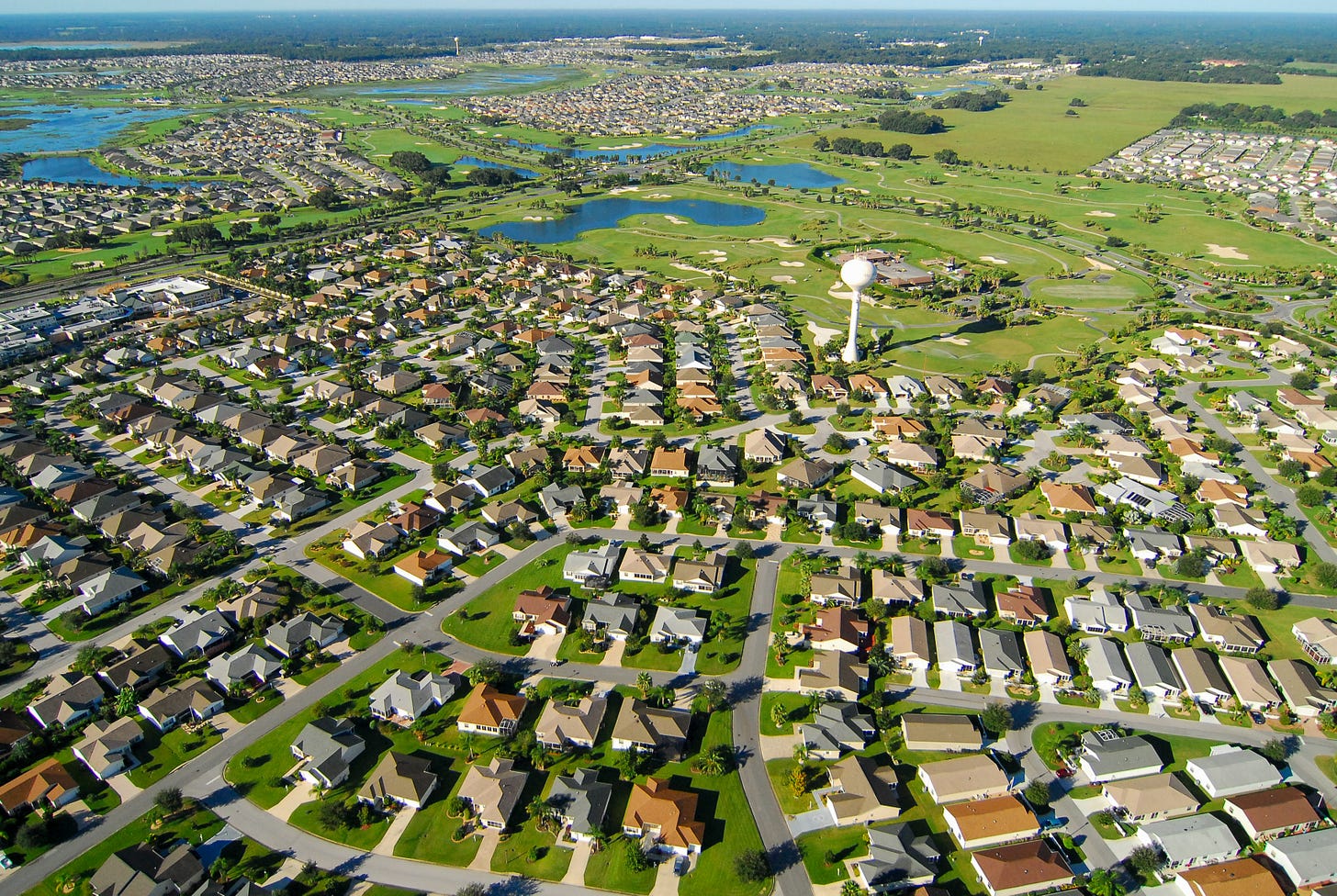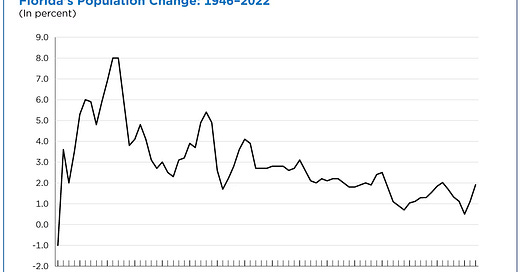The bullshit environmentalism of NIMBYs
Dense development done right is environmentally friendly despite NIMBY protests.
Florida’s population is growing. That’s not really new news. Carl Hiaasen has been writing and speaking about this for years. I’ve joked that Florida doesn’t make a whole lot of things. I know this isn’t true but at times, it does seem like our main industries do seem to be tourism and population growth, and of course the two are tied. Come for a vacation, stay for a lifetime…or at least until the endless humid summer finally breaks you.
Since 1946, Florida’s population has been growing and all that growth has led some 22 million+ people living in the state now. Population growth in and of itself is not a bad thing. People like this state! There’s a lot to like here! But managing that growth is a challenge, and like most challenges in Florida, many elected officials in the state are not up for the job.
Recently, I drove from Gainesville down to Orlando on the Turnpike. I’ve done this trip so many times. Back when I was in college in the early 2000s, once I got past Ocala heading south, I didn’t really come across much of anything but trees and the occasional rest stop until I got near the Turkey Lake Service Plaza. Florida is usually thought of as being pretty flat, but that area had some really beautiful rolling hills covered with trees. Now when I drive past that area, I notice that many of those trees are gone, having been plowed over to create housing subdivisions, cookie cutter houses with driveways and lawns, streets than end in cul-de-sacs. And of course now there’s more traffic too. And with more traffic comes the tried and failed solution of adding more lanes, which is what is currently happening with that stretch of the Turnpike.
Wildwood and the Villages now have a population over 150,000 people. The Ocala Metro Area, a hilarious term given how uncity-like Ocala is, is up to more than 409,000 people. On a detour off the Turnpike (the traffic was bad enough that it wasn’t the fastest route to Orlando), I saw old forests being clear cut to make more additions to the Villages. All those people who want to move there need somewhere to live.
So why do they live there and not in already established cities? I can’t boil it down to one reason. Why people live in a given place is influence by a multitude of factors, from personal taste to proximity to family and friends. But I’ll bet one reason Florida’s growing population is heading for the suburbs and exurbs is because the housing is so much cheaper. And that is a disaster.
Cities have zoned themselves out of affordable housing by locking in single family homes as the dominant housing type. There’s only so much horizontal space we can use to house people near jobs and amenities so when that limited space is taken, people look further out for cheaper housing, justifying the longer commutes and increased travel costs with lower mortgage payments or lower rent. This is how we get forests cut down to make way for housing subdivisions that aren’t walkable or bikeable. This is how we get people locked into car dependency. This is how we get hundreds of millions of dollars spent to widen the Turnpike, knowing full well it won’t work for long to alleviate traffic.
Wait, why don’t we just build in cities near jobs again? Oh right, in some places, the fight against allowing more multifamily housing or even slightly taller single family housing or even just smaller single family housing lots is fierce. People who are referred to as NIMBYs (not in my backyard)1 will come out in full force to city meetings if a rezoning is proposed to allow for more dense housing. One of the arguments trotted out is the environment. As the argument goes, well if we allow these townhomes/apartments/condos/smaller houses to be built, what will happen to all the green space we have? the lawns? the individual trees? A very micro environmental argument is used to dissuade multifamily housing from going up. Now where, pray tell, are the NIMBY environmentalists when entire forests are cleared to create sprawling car dependent communities? When a forest is at stake, when a bigger picture environmental disaster is about to unfold that will lead to a persistent cycle of environmental damage, they’re silent. After all, how can a single family house be bad? There’s a tree on the lot, and there’s a“greenspace” with the lawn. Lawns, of course, are basically useless unless you let them grow wild, which very few people do. A wild space? Not in my front yard! All of which is to say the environmental arguments frequently trotted to rail against new multifamily housing are largely bullshit.

The worst thing we can do in our communities is increase and lock in car dependency. We have decades of experience now to show us how bad that is. Cars are expensive so car dependency disproportionately hurts people with lower incomes. More cars = more traffic and the solution to that has always been wider roads, even though they don’t work. Wider roads are a disaster environmentally and for any would-be pedestrians who have to cross them. Cars themselves are a huge environmental drag, even electric ones, as pollution comes not just from exhaust but also from tires and the materials used to make batteries. Car dependency means longer commutes and less personal interaction and more isolation.
You know what would make a dent in car dependency? Making it easier to build housing near jobs, restaurants, schools, churches, services, and more. Instead of seeing our cities as having specific zones for a type of business, just have housing next to or on top of offices and restaurants. It works incredibly well in most of the world and has for quite some time. Putting stuff near homes means you might be able to walk from your home to somewhere useful. People who live in denser communities tend to have a significantly smaller carbon footprint as a result. Once more for the misguided NIMBY environmentalists: dense development leads to a smaller carbon footprint for the people who live there. And it can’t be an island of apartments with stroads between them and jobs. It has to be mixed in with other housing types and businesses. The more we do that, the less we have suburban sprawl, the type of development that is truly environmentally destructive. For the sake of a forest, we might have to give up a lawn. If you care about the environment at all (or public health or safety or climate change), it seems like a damn fine trade.
I would like to propose a change to this term because it’s not accurate. Very often NIMBYs are not only against things in their backyards but also everyone else’s, even if they live very far away from the site in question.



